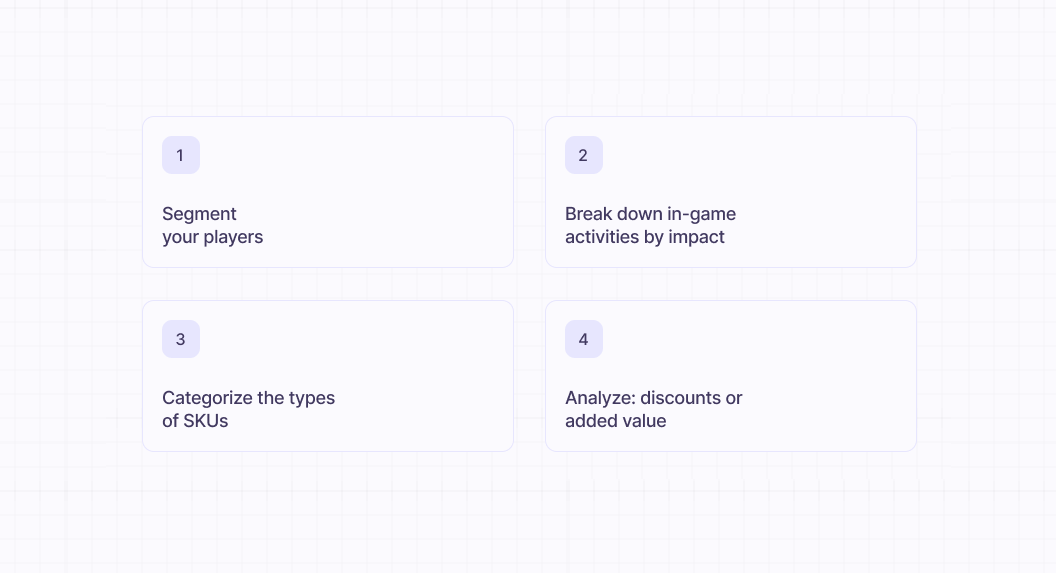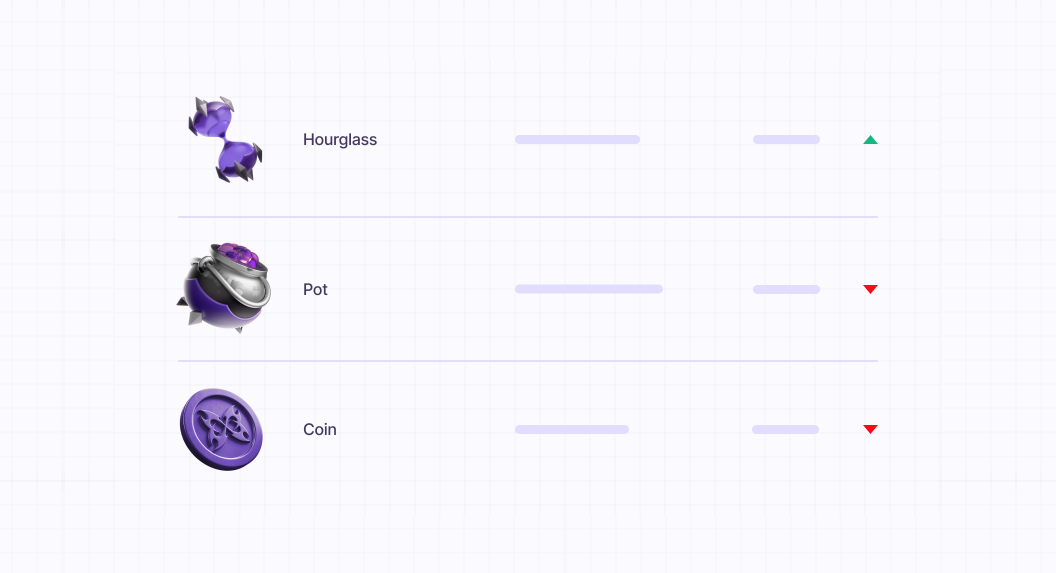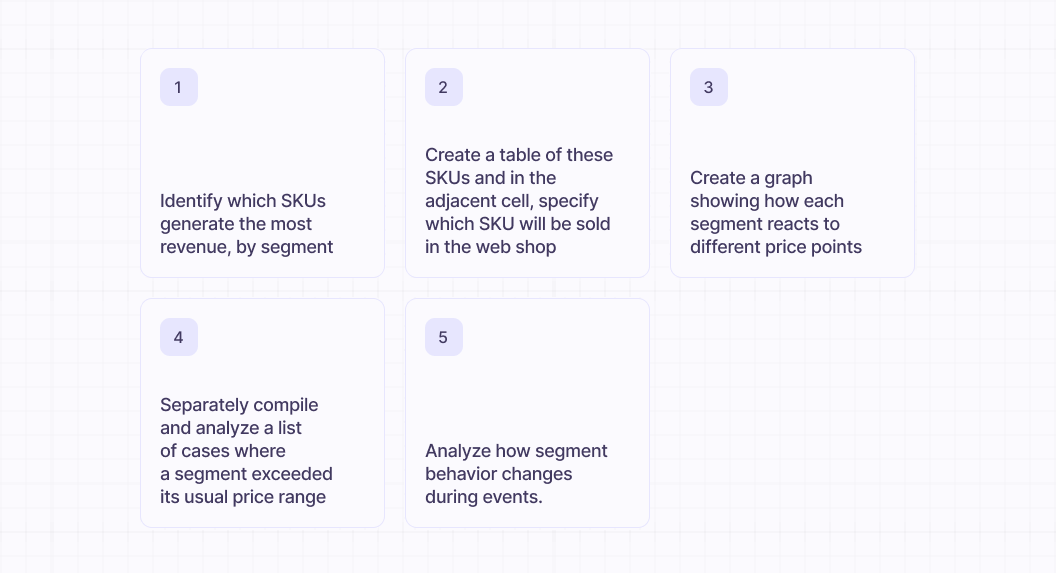Revenue
Marketing
User engagement
Your web shop pre-launch: Focus on success
June 13, 2024
As video game professionals, we inherently understand the importance of a well-polished launch. Like a game, a web shop's success hinges on a strong initial offering.
This article series will delve into the key actions before launching your web shop, ensuring a smooth rollout and a foundation for future growth through data-driven improvements. Consider it the pre-alpha phase for your online storefront – prepare strategically, launch effectively, and iterate based on player feedback, just like you would with your game.
Today’s blog post is inspired by Artem Liubutov’s Linkedin article.
 Treating your web shop as a branch of your game’s overall experience can benefit you and your players.
Treating your web shop as a branch of your game’s overall experience can benefit you and your players.
 Step 1: Perform a competitive analysis
Building a video game web shop expands revenue streams and player engagement. However, before jumping in, it's crucial to analyze competitive (successful) web shops within your genre to uncover valuable insights that inform your own web shop strategy.
Conducting competitive research can feel daunting, but its benefits outweigh the effort.
Competitive research hack #1: Reach out to companies with expertise in video game commerce and monetization.
Xsolla launched over 500 Web Shops and we’re always happy to answer your questions — whether or not you decide to partner with us.
Step 1: Perform a competitive analysis
Building a video game web shop expands revenue streams and player engagement. However, before jumping in, it's crucial to analyze competitive (successful) web shops within your genre to uncover valuable insights that inform your own web shop strategy.
Conducting competitive research can feel daunting, but its benefits outweigh the effort.
Competitive research hack #1: Reach out to companies with expertise in video game commerce and monetization.
Xsolla launched over 500 Web Shops and we’re always happy to answer your questions — whether or not you decide to partner with us.
Ultimately, your goal should be to balance operational investments and financial returns. Here are the areas to focus your attention on. Step 3: Scrutinize the SKUs and offers that sell
Let’s talk about analyzing in-game store data to understand player spending habits and optimize your web shop offerings.
Step 3: Scrutinize the SKUs and offers that sell
Let’s talk about analyzing in-game store data to understand player spending habits and optimize your web shop offerings.
 After examining how different player segments interact with your web shop, create reports that categorize each segment's SKUs (store items) by profitability — thereby revealing spending preferences. Focus on how these segments react to different price points. Key questions to ask yourself include:
After examining how different player segments interact with your web shop, create reports that categorize each segment's SKUs (store items) by profitability — thereby revealing spending preferences. Focus on how these segments react to different price points. Key questions to ask yourself include:
 This analysis helps us optimize key metrics like average purchase value and repeat purchases by allowing you to move players up the spending tiers – potentially turning Dolphins into Whales and Whales into Super Whales.
Limited-time events offer valuable insights as they present exclusive or highly desirable items in a unique context for players. This temporary environment mimics the core function of your web shop – selling unique and valuable items. Analyzing how players in each segment respond to these events helps identify crucial patterns that inform future web shop strategies. We'll discuss the practical applications of these learnings in another post.
By understanding player spending habits and preferences, you can tailor your web shop offerings to maximize revenue and keep players engaged.
This analysis helps us optimize key metrics like average purchase value and repeat purchases by allowing you to move players up the spending tiers – potentially turning Dolphins into Whales and Whales into Super Whales.
Limited-time events offer valuable insights as they present exclusive or highly desirable items in a unique context for players. This temporary environment mimics the core function of your web shop – selling unique and valuable items. Analyzing how players in each segment respond to these events helps identify crucial patterns that inform future web shop strategies. We'll discuss the practical applications of these learnings in another post.
By understanding player spending habits and preferences, you can tailor your web shop offerings to maximize revenue and keep players engaged.
 In upcoming posts, we’ll zoom in on:
In upcoming posts, we’ll zoom in on:
Your mobile game and your shop: kindred spirits
This post dives into a crucial concept for game developers: your web shop isn't just a separate sales channel. It's an extension of your game. Why should you treat your ecommerce plan with the same reverence you do your game? Here’s why it matters.- Player experience: The web shop should reflect your game's UI, atmosphere, and community. For players, it should continue the game experience—one that fosters immersion, engagement, and long-term loyalty.
- Monetization strategy: A well-designed web shop offers players additional ways to interact and potentially spend. A smooth UI caters to "super whales" —highly engaged spenders— and helps drive revenue beyond in-game purchases.
- Metrics and data: A web shop integrated with your game can provide valuable insights into player behavior, optimize in-game monetization and bolster the overall player experience.
 Treating your web shop as a branch of your game’s overall experience can benefit you and your players.
Treating your web shop as a branch of your game’s overall experience can benefit you and your players.
- Improved player lifetime value (LTV): Engaged players spend more, leading to a longer and more profitable player lifecycle.
- Enhanced in-game revenue: Strategic web shop offerings can encourage players to spend more in-game.
- Competitive advantage: A holistic approach to monetization can make your game harder for competitors to use industry tools to dissect and mirror your success methodology.
Practical steps to web shop analysis
A successful web shop launch hinges on understanding the market and your audience. Here's a focused approach to pre-launch optimization that will maximize your long-term impact.- Analysis of successful web shops in similar genres;
- Evaluation of your target audience;
- Scrutiny of SKUs and offers to find what sells well in the game.
 Step 1: Perform a competitive analysis
Building a video game web shop expands revenue streams and player engagement. However, before jumping in, it's crucial to analyze competitive (successful) web shops within your genre to uncover valuable insights that inform your own web shop strategy.
Conducting competitive research can feel daunting, but its benefits outweigh the effort.
Competitive research hack #1: Reach out to companies with expertise in video game commerce and monetization.
Xsolla launched over 500 Web Shops and we’re always happy to answer your questions — whether or not you decide to partner with us.
Step 1: Perform a competitive analysis
Building a video game web shop expands revenue streams and player engagement. However, before jumping in, it's crucial to analyze competitive (successful) web shops within your genre to uncover valuable insights that inform your own web shop strategy.
Conducting competitive research can feel daunting, but its benefits outweigh the effort.
Competitive research hack #1: Reach out to companies with expertise in video game commerce and monetization.
Xsolla launched over 500 Web Shops and we’re always happy to answer your questions — whether or not you decide to partner with us.Ultimately, your goal should be to balance operational investments and financial returns. Here are the areas to focus your attention on.
- Product mix: Identify which in-game items are offered on competitor web shops to reveal popular items players are willing to purchase separately.
- Pricing strategy: Analyze the price points used on competitor web shops compared to in-game pricing — establishing a baseline for your own pricing strategy.
- Monetization techniques: Examine the types of mechanics employed by successful web shops. The list might include loyalty programs, special offers, virtual currency systems (like piggy banks or gacha mechanics), etc. Understanding these methods can help you choose the most effective ones for your game.
- User experience (UX): Look at the authorization process for web shop purchases. Is it streamlined and user-friendly? Additionally, see if the web shop employs personalization features to cater to individual players.
- Player communication: Analyze how competitor games inform players about their web shops. Effective communication is key to driving traffic and sales to your own web shop.
- Discounts reduce your profit margin through lower ARPU;
- Super whales might perceive discounts as cheapening the brand;
- Discounts can lead to a trap, where ever-larger discounts are needed to drive sales, harming profitability.
 Step 3: Scrutinize the SKUs and offers that sell
Let’s talk about analyzing in-game store data to understand player spending habits and optimize your web shop offerings.
Step 3: Scrutinize the SKUs and offers that sell
Let’s talk about analyzing in-game store data to understand player spending habits and optimize your web shop offerings.
 After examining how different player segments interact with your web shop, create reports that categorize each segment's SKUs (store items) by profitability — thereby revealing spending preferences. Focus on how these segments react to different price points. Key questions to ask yourself include:
After examining how different player segments interact with your web shop, create reports that categorize each segment's SKUs (store items) by profitability — thereby revealing spending preferences. Focus on how these segments react to different price points. Key questions to ask yourself include:
- Do high spenders primarily purchase the most expensive offers, or do they buy mid-tier items more frequently?
- What is the maximum price point Dolphins are comfortable with (their "price ceiling")?
- Did any segments deviate from their usual spending patterns (outliers)? If so, you should further analyze these cases to identify trends. This might involve understanding the events leading up to the outlier purchase and determining if specific in-game events or monetization mechanics influenced the purchase.
 This analysis helps us optimize key metrics like average purchase value and repeat purchases by allowing you to move players up the spending tiers – potentially turning Dolphins into Whales and Whales into Super Whales.
Limited-time events offer valuable insights as they present exclusive or highly desirable items in a unique context for players. This temporary environment mimics the core function of your web shop – selling unique and valuable items. Analyzing how players in each segment respond to these events helps identify crucial patterns that inform future web shop strategies. We'll discuss the practical applications of these learnings in another post.
By understanding player spending habits and preferences, you can tailor your web shop offerings to maximize revenue and keep players engaged.
This analysis helps us optimize key metrics like average purchase value and repeat purchases by allowing you to move players up the spending tiers – potentially turning Dolphins into Whales and Whales into Super Whales.
Limited-time events offer valuable insights as they present exclusive or highly desirable items in a unique context for players. This temporary environment mimics the core function of your web shop – selling unique and valuable items. Analyzing how players in each segment respond to these events helps identify crucial patterns that inform future web shop strategies. We'll discuss the practical applications of these learnings in another post.
By understanding player spending habits and preferences, you can tailor your web shop offerings to maximize revenue and keep players engaged.
In conclusion
This wraps up our exploration of core web shop analysis concepts. While there's always more to delve into, this foundation equips you to boost your game's success significantly. The data you meticulously gather will play a central role in making critical pre-launch decisions. In upcoming posts, we’ll zoom in on:
In upcoming posts, we’ll zoom in on:
- UX design and frictionless transactions: Why minimizing player frustration is paramount.
- Geographic considerations and Localization: Tailoring your game for different regions and languages.
- Retention mechanics: Strategies to keep players engaged for the long haul.
Take the next step!
Ready to go direct-to-players and launch a lucrative Web Shop of your own? Schedule a time to chat with one of our game commerce experts. We are always happy to help you take your creative project to the next level.Popular
GET THE LATEST CONTENT DELIVERED TO YOUR INBOX
Featured content
5 minute read
Payments
Offering local payment methods fuels conversions and revenue
This article explores how offering players their ideal choice of purchasing game content can enhance conversion rates, increase revenue, build trust, and provide a competitive edge.2 minute read
Community Growth
Xsolla and UKIE partner up for a brighter future in the gaming industry
Xsolla is teaming up with UKIE to support game developers in the UK and EMEA through practical resources, workshops, and industry events.3 minute read
Payments
Payment processing best practices for indie developers
Best practices to solve ecommerce problems, streamline ecommerce transactions, and ensure security and complianceDIGITAL GUIDE
Free guide
BOOST PLAYER ENGAGEMENT WITH REWARDS
Learn how you can grow your community with rewards during all stages of your game development. Download our free guide.
READY TO LEVEL UP?
The Xsolla team is ready to help.Your game business is our #1 priority.
